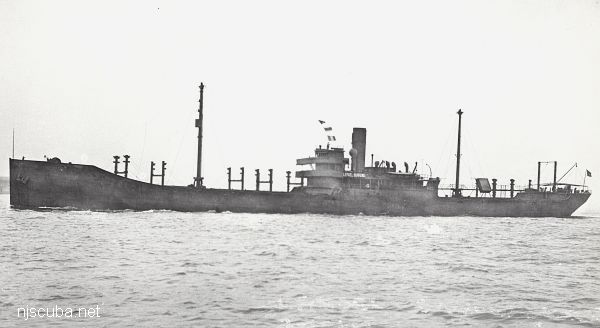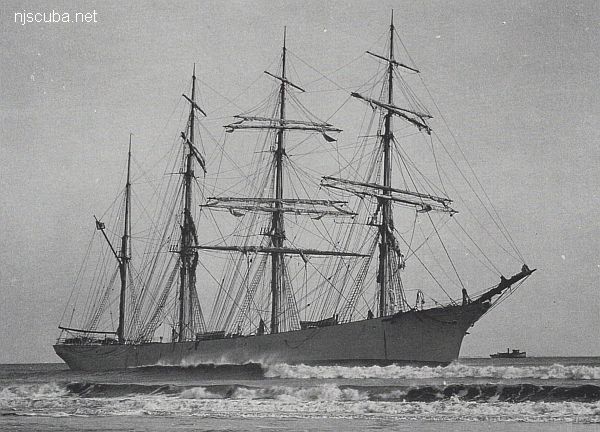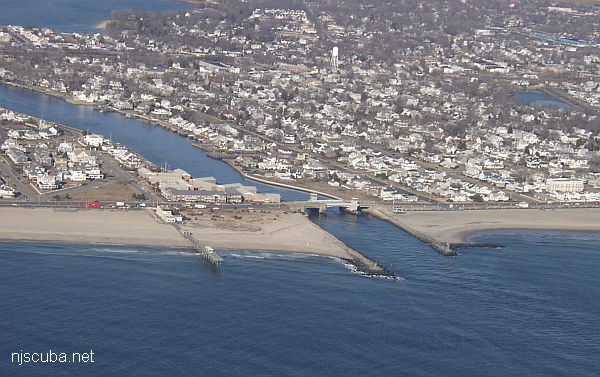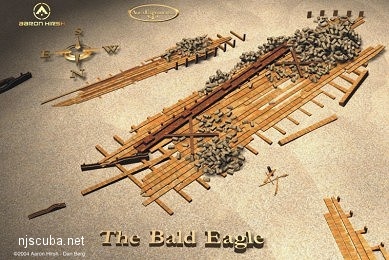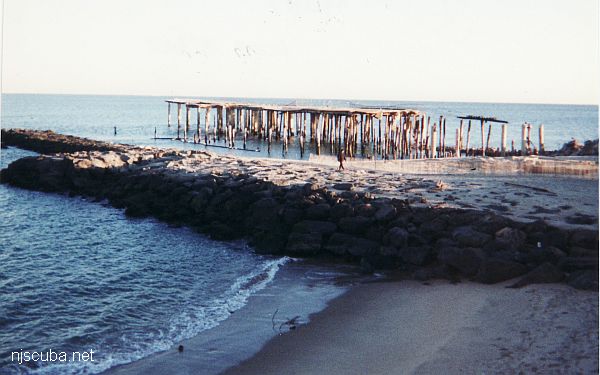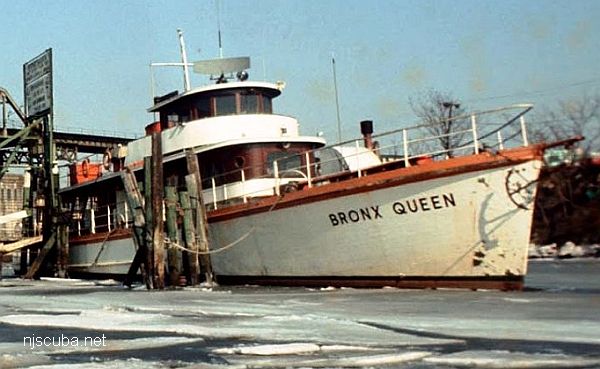New Jersey Dive Sites
- Barnegat Chart ...
- Cape May Chart ...
- Manasquan Chart ...
- Sandy Hook Chart ...
- 120 Wreck
- Absecon Inlet
- Across Wreck
- Adele
- Admiral DuPont
- Adriatic
- Alex Gibson
- Alex Mac
- Alexander Hamilton
- Allenhurst Jetty
- Almirante
- American
- Anastasia
- Andrea Doria
- Antioch
- Arnoff
- Arundo
- Asfalto
- Astra
- Atlantic City Reef ...
- Atlantus
- Aurora
- Axel Carlson Reef ...
- Ayrshire
- Ayuruoca
- Azua
- BA Wreck
- Balaena
- Bald Eagle
- Barge #10
- Barnegat Bay
- Barnegat Inlet
- Barnegat Light Reef ...
- BD 1738
- Beach Jetties
- Benson
- Beth Dee Bob
- Black Warrior
- Blue Boy
- Bluff's Wreck
- Bonanza
- Brian C
- Brick barge
- Brigantine Beach Wreck
- Brigantine Buoy Wreck
- Brigantine Inlet
- Bronx Queen
- Brunette
- Caddo
- Cadet
- Cape May Inlet
- Cape May Reef ...
- Capt. Smitty
- car float
- Cassandra
- Catherine Jackson
- Cecilia M. Dunlap
- Champion
- Chaparra
- Charlemagne Tower
- Charles Dunlap
- Chauncey Jerome
- Chesapeake
- China Junk Wreck
- China Wreck
- Choapa
- City of Athens
- City of Georgetown
- clam boat
- Clermont
- Continent
- Cornelia Soule
- Cornelius Grinnell
- Cornelius Hargraves
- Corson's Inlet
- crane barge
- Daghestan
- Deepwater Reef ...
- Delaware
- Delaware #09 Reef
- Delaware #10 Reef ...
- Delaware #11 Reef ...
- Delaware Bay
- Delaware Bay Reef
- Delaware Water Gap
- DelJerseyLand Reefs ...
- Dorothy B Barrett
- drydock barge
- Dryland
- Dual Wrecks
- Duncan
- Dutch Springs (Lake Hydra) ...
- Edmund Phinney
- Edward W. Winslow
- Elberon Rocks
- Elizabeth Warren
- Emerald
- Eugene F Moran
- Eureka
- Evening Star
- F.F. Clain
- Florida
- Fort Victoria
- Francis A Perkins
- G.L. 78
- Garden State N Reef ...
- Garden State S Reef ...
- Gassoon
- General Slocum
- German
- Glen II
- Glory
- Glory Wreck
- Goulandris
- Granite Wreck
- Great Egg Inlet
- Great Egg Reef ...
- Great Isaac
- Gulf Trade
- Gypsum Prince
- Gypsy
- H.W. Long
- Hankins Wrecks
- Harry Rush
- Hereford Inlet
- HMS Pentland Firth
- Hornet
- Hudson/East Rivers
- Iberia
- Ida K SC-1282
- Immaculata
- Inshore Barge/Tug
- Irene/Truro
- Jack-I
- Joan LaRie III
- John Marvin
- John Minturn
- Kennebec
- King Cobra
- Klondike Rocks
- Lana Carol
- Larsen
- Lavallette Wreck
- Lemuel Burrows
- Leon Walter
- Lido (Coal Wreck)
- Lillian
- Little Egg Reef ...
- Little Egg/Holgate Inlet
- Lizzie D
- Lizzie H. Brayton
- Locomotives
- Logwood
- Long Branch Pier
- Macedonia
- Mahogany
- Malta
- Manasquan Inlet
- Manasquan Inlet Filling In
- Manasquan Reef ...
- Manasquan River
- Manasquan Wreck
- Manhattan
- Marion
- Maurice Tracy
- Mediator
- Meta
- Middle Barge
- Mistletoe
- Misty Blue
- Mohawk
- Mohawk (older)
- Montgomery
- Mud Hole
- Mullica River Wrecks
- Nautilus
- Navesink River
- New Deal
- New Era
- New Jersey Aquarium
- New Jersey Artificial Reefs ...
- Northeast Sailor
- Northern 29
- Northern Pacific
- Nuphar
- NW Barges
- Ocean City Reef ...
- Offshore Tugboat
- Olsen
- Park City
- Patrice McAllister
- Peerless
- Persephone
- Pet Wreck
- Pinta
- Pipe Barge
- Pliny
- Plymouth
- Pocopson
- Poseidon
- R.C. Mohawk
- Railroad Bridge
- Ramos
- Ranald
- Ranger
- Raritan Bay
- Raritan River
- Reliable
- Relief Lightship
- Remedios Pascual
- Rickseckers
- Ridge Schooner
- Riggy Barge
- RJ Walker
- Rjukan
- Robert A Snow
- Round Valley
- Roy's Barge
- RP Resor
- Rudder Wreck
- Rump
- Ruth Shaw
- Sachem
- Salem
- San Jose
- San Saba
- Sandy Hook
- Sandy Hook Pilot
- Sandy Hook Reef ...
- SC-60
- Scotland
- Sea Girt
- Sea Girt Inlet
- Sea Girt Reef ...
- Sea Girt Wreck
- Sea Hag
- Seaside Crane barge
- Shark River
- Shark River - A Street
- Shark River - Back Bay
- Shark River Inlet
- Shark River Reef ...
- Shrewsbury Rocks
- Simala
- Sindia
- Slabs
- Spring Lake Sailor
- Steel Wreck
- Stolt Dagali
- Sumner
- SW Mohawk
- Sylvanus
- Tampa III
- Texas Tower
- Three Sisters
- Thurmond
- Tolten
- Townsend's Inlet
- Townsend's Inlet Reef ...
- Triangle Wrecks
- Troop Carrier
- U-869
- u01 - AWOIS 8087
- u02 - AWOIS 12966/11422
- u03 - AWOIS 1609
- u04 - AWOIS 8084
- u05 - AWOIS 7940
- u06 - AWOIS 7938
- u07 - AWOIS 8076
- u08 - AWOIS 4600
- u09 - AWOIS 8075
- u10 - AWOIS 8097
- u11
- u12 - AWOIS 7509
- u13 - AWOIS 7932
- u14 - AWOIS 9768
- USS Jacob Jones
- USS S-5
- USS Turner
- Valerie E
- Varanger
- Vega
- Vivian
- Vizcaya
- Wayne
- Western World
- Wildwood Reef ...
- William B. Diggs
- William R Farrell
- Yellow Flag
- YP-387

